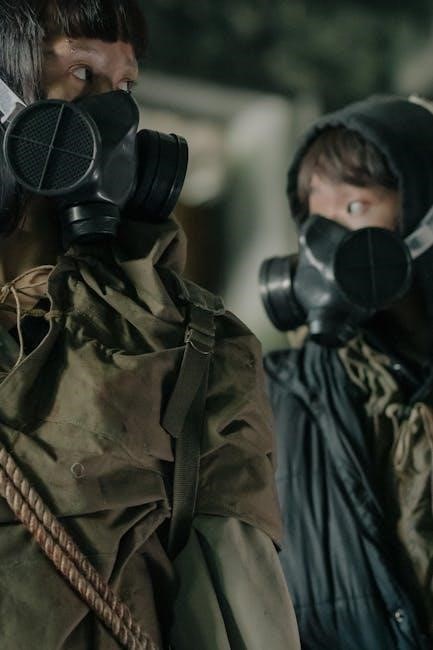An essential apocalypse survival guide PDF offers comprehensive strategies, tools, and expert tips to prepare for catastrophic events․ These guides cover basic supplies, shelter planning, and mental resilience, ensuring readiness for any scenario․
1․1 Importance of Preparedness
Preparedness is the cornerstone of survival, ensuring a proactive approach to potential disasters․ A well-structured apocalypse survival guide PDF emphasizes the need for mental resilience, essential supplies, and strategic planning․ By understanding risks and adapting strategies, individuals can navigate chaos more effectively․ Preparedness fosters confidence, enabling calm decision-making during crises․ It also ensures access to critical resources, making the difference between survival and vulnerability․ Stay informed, plan meticulously, and remain adaptable to thrive in uncertain scenarios․
1․2 Overview of Apocalypse Scenarios
An apocalypse survival guide PDF typically outlines various catastrophic scenarios, such as zombie outbreaks, natural disasters, or societal collapses․ These guides provide insights into potential risks, enabling readers to understand the challenges they may face․ From pandemics to environmental disasters, the content is designed to address diverse threats․ By exploring these scenarios, individuals can better prepare for the unexpected, ensuring they are equipped to handle life-threatening situations effectively․ Knowledge of these scenarios is key to developing a robust survival plan․
1․3 Key Principles of Survival
Understanding the key principles of survival is crucial for navigating apocalyptic scenarios․ These principles include securing essential supplies, mastering basic skills, and maintaining a resilient mindset․ Adaptability and resourcefulness are vital, as situations can change rapidly․ Building alliances and relying on community support can also enhance survival chances․ Learning from expert strategies and real-world examples ensures a well-rounded approach․ By focusing on these core principles, individuals can increase their likelihood of enduring even the most challenging conditions․ Preparedness is the foundation of survival․

Understanding the Apocalypse
Exploring the concept of the apocalypse involves examining various catastrophic scenarios, from natural disasters to societal collapses․ Understanding these events is key to effective preparedness and survival strategies․

2․1 Types of Apocalyptic Events
Apocalyptic events include natural disasters like earthquakes and pandemics, societal collapses, and supernatural scenarios such as zombie outbreaks․ Each type demands unique survival strategies, from stockpiling supplies to mastering combat skills․ Understanding these variations ensures tailored preparedness, enhancing chances of survival in diverse catastrophic situations․
2․2 Historical Precedents and Lessons
Historical events like the Black Death, World War II, and the 1918 Spanish Flu offer valuable lessons for apocalyptic survival․ The Black Death taught isolation and hygiene, while WWII emphasized community cooperation and rationing․ The Spanish Flu highlighted the importance of public health measures․ These precedents provide insights into human resilience, resource allocation, and societal response, shaping modern survival strategies and preparedness plans for future crises․
2․3 Psychological Impact of Apocalypse
The psychological toll of an apocalypse can be devastating, leading to anxiety, trauma, and despair․ Isolation, loss of loved ones, and constant danger erode mental health․ Survivors often experience PTSD, while others may find purpose in resilience․ Building mental resilience is crucial, as is fostering social bonds and maintaining hope․ These strategies help individuals cope with the emotional and psychological challenges of a catastrophic event, ensuring survival not just physically but mentally as well․

Preparation and Planning
Effective preparation involves stockpiling essential supplies like food, water, and first aid kits․ Strategic planning includes mapping escape routes and identifying safe shelters, ensuring readiness for any crisis․
3․1 Essential Supplies for Survival
Stockpiling essential supplies is critical for enduring catastrophic events․ Include non-perishable food, bottled water (at least 1 gallon per person daily), and a first aid kit․ Add a portable water filtration system, multi-tool, flashlight, and extra batteries․ Communication tools like a radio and whistle are vital․ Pack warm clothing, blankets, and hygiene items․ Don’t forget ammunition, firearms, and self-defense gear․ Organize supplies in a portable bug-out bag for quick escapes, ensuring readiness for any apocalyptic scenario․
3․2 Choosing the Right Gear and Equipment
Selecting the right gear is crucial for survival․ Opt for durable, multi-functional tools like a water filtration system, multi-tool knife, and solar-powered devices․ Include a reliable firearm, ammunition, and protective gear such as a helmet and body armor․ A portable stove, sleeping bag, and navigation tools like a compass and GPS are essential․ Prioritize lightweight, high-quality items that adapt to various environments․ Always consider the balance between utility and weight to ensure mobility in apocalyptic scenarios․
3․3 Creating a Bug-Out Bag
A well-prepared bug-out bag is vital for immediate evacuation․ Include essentials like 3 days of water, non-perishable food, and a first-aid kit․ Add a flashlight, extra batteries, multi-tool, and communication devices․ Pack lightweight shelter options such as a tarp or tent․ Incorporate personal documents, maps, and a portable stove for versatility․ Ensure the bag is durable, easily accessible, and weighs no more than 20% of your body weight for easy transport during emergencies․
3․4 Identifying Safe Shelters and Routes
Identifying safe shelters and routes is crucial for survival․ Look for structures with sturdy foundations, such as basements or underground bunkers, to protect against extreme weather or attacks․ Avoid areas prone to flooding or collapse․ Plan alternative routes to avoid bottlenecks and disaster zones․ Use maps to locate safe zones and emergency services․ Scout for natural shelters like caves or forests if urban options are unavailable․ Always prioritize accessibility and visibility when selecting a shelter or path․

Survival Skills and Strategies
Mastering self-reliance, adaptability, and practical knowledge of first aid and resource gathering is vital for enduring apocalyptic conditions․
4․1 Basic Survival Skills
Mastering basic survival skills, such as finding clean water, building shelters, and starting fires, is crucial for staying alive in post-apocalyptic scenarios․ Learning to navigate, signal for help, and perform basic first aid ensures a strong foundation for survival․ These skills, often detailed in apocalypse survival guide PDFs, are essential for individuals to thrive in harsh environments․ Practicing these techniques beforehand can significantly improve chances of survival during catastrophic events․
4․2 Advanced Survival Techniques
Beyond the basics, advanced survival techniques include crafting tools, purifying water, and cultivating food․ These methods, often outlined in apocalypse survival guide PDFs, enhance long-term sustainability․ Techniques like trap-making, self-defense strategies, and resource optimization are vital for prolonged survival․ These skills require practice and adaptability, ensuring individuals can overcome complex challenges in a post-apocalyptic world․
4․3 Adaptation to Different Environments
Adapting to diverse environments is crucial for survival; Urban, wilderness, and coastal areas require unique strategies․ Survival guides often emphasize understanding local ecosystems, building appropriate shelters, and sourcing water․ Skills like foraging, navigation, and weather prediction are essential․ In urban settings, scavenging and avoiding hazards are key, while wilderness survival focuses on natural resource utilization․ Coastal areas may involve fishing and boat crafting․ Mastery of these techniques ensures adaptability and increases chances of survival in any post-apocalyptic landscape․
4․4 Defense and Combat Tactics
Mastering defense and combat tactics is vital for survival․ Survival guides emphasize creating barriers, using improvised weapons, and employing stealth․ Forming alliances can enhance security, while understanding enemy behavior helps in strategic planning․ Training in hand-to-hand combat and marksmanship is crucial․ Additionally, knowing when to retreat or avoid confrontation can save lives․ These strategies ensure preparedness for both short-term threats and long-term security challenges in a post-apocalyptic world․

Mental and Emotional Preparedness
Mental resilience is key to surviving apocalyptic scenarios․ Techniques like mindfulness, positive thinking, and emotional regulation help maintain calm․ Building strong social bonds and maintaining morale are crucial․
5․1 Building Mental Resilience
Building mental resilience is crucial for surviving apocalyptic scenarios․ Techniques like mindfulness, self-care, and reframing challenges help maintain emotional stability․ Accepting reality, focusing on actionable steps, and fostering hope are key․ Resilience grows through practice, enabling individuals to adapt to extreme conditions and maintain clarity under stress; Strengthening mental fortitude ensures better decision-making and the ability to thrive in uncertain environments․
5․2 Managing Fear and Anxiety
Managing fear and anxiety is vital during an apocalypse․ Techniques like deep breathing, grounding exercises, and focusing on actionable steps help calm the mind․ Acknowledging fear without letting it overwhelm is key․ Staying informed but avoiding excessive exposure to stressors can prevent anxiety escalation․ Building a support network and maintaining routines fosters stability․ Effective coping mechanisms ensure clarity and focus, empowering individuals to navigate chaotic situations with greater emotional control and resilience․
5․3 Importance of Social Bonds
Social bonds are crucial for survival in an apocalypse․ Strong relationships provide emotional support, shared responsibilities, and collective protection․ Trust and cooperation within a group enhance resource gathering, decision-making, and safety․Community ties foster resilience, reducing feelings of isolation and despair․ Building and maintaining connections ensures a support system, which is essential for long-term survival and rebuilding society․ Prioritizing relationships strengthens overall well-being and increases chances of enduring catastrophic events together․
5․4 Coping with Loss and Trauma
Coping with loss and trauma during an apocalypse requires acknowledgment of grief and proactive emotional care․ Establishing rituals, such as memorials, can help process loss․ Seeking support from trusted individuals or groups fosters healing․ Maintaining a daily routine and focusing on survival goals provides structure․ Emotional resilience is built by accepting reality, embracing hope, and finding purpose․ Addressing trauma early prevents long-term psychological damage, ensuring mental stability for enduring challenges․

Community and Alliances
Building strong alliances and fostering community bonds are crucial for survival․ Collaborative efforts enhance resource sharing, mutual support, and collective defense, ensuring greater resilience in catastrophic scenarios․
6․1 Forming Survival Groups
Forming a survival group is essential for maximizing resources and skills․ A diverse group with expertise in medicine, engineering, and combat enhances overall resilience․ Trust and communication are critical, as cohesion ensures better decision-making․ Roles should be clearly defined to avoid conflicts and ensure efficiency․ A strong leader can guide the group, while mutual respect fosters unity․ Building such a network increases chances of survival, as collective strength often surpasses individual efforts in catastrophic scenarios․
6․2 Communication and Coordination
Effective communication and coordination are vital for group survival․ Establishing a reliable communication system, such as two-way radios or whistle signals, ensures clarity in emergencies․ Designated roles and protocols help avoid confusion, while regular check-ins maintain accountability․ Clear messaging prevents panic and ensures decisions are unified․ Coordination fosters resource sharing and strategic planning, enhancing the group’s ability to adapt and thrive in challenging environments․
6․3 Conflict Resolution Strategies
Conflict resolution is crucial for maintaining group cohesion․ Establishing clear rules and a decision-making hierarchy helps prevent disputes․ Mediation by neutral parties can address tensions before they escalate․ Encouraging open dialogue fosters understanding and compromise․ Training in emotional control and empathy aids in de-escalating conflicts․ Prioritizing the group’s survival over individual interests ensures unity․ Having a plan for resolving disagreements strengthens trust and collaboration, essential for long-term survival․
6․4 Roles and Responsibilities Within a Group
In a survival group, clear roles ensure efficiency and safety․ A leader coordinates decisions, while a resource manager handles supplies․ A security officer protects the group, and a medic provides medical aid․ An engineer maintains equipment, and a scout gathers intelligence․ Each member’s role aligns with their strengths, fostering collaboration․ Defined responsibilities reduce confusion and enhance overall survival chances, ensuring everyone contributes meaningfully to the group’s well-being․

Learning from Popular Culture
Popular culture provides essential survival lessons through movies, books, and games, emphasizing adaptation, resourcefulness, and teamwork․ These narratives offer practical strategies and inspire preparedness for real-world challenges․
7․1 Lessons from Zombie Apocalypse Movies
Zombie apocalypse movies offer valuable survival insights, such as securing safe locations, scavenging for supplies, and prioritizing teamwork․ These films emphasize the importance of adaptability and quick decision-making․ For instance, Max Brooks’ The Zombie Survival Guide translates fictional strategies into practical advice․ Movies also highlight common pitfalls, like underestimating threats or poor communication, serving as cautionary tales․ By analyzing these narratives, viewers can glean actionable tips for real-world preparedness and crisis management․
7․2 Insights from Survival Video Games
Survival video games like H1Z1: Just Survive and The Last of Us provide practical lessons in resource management, crafting, and decision-making․ Players learn to prioritize shelter, ration supplies, and adapt to environments․ These games also emphasize teamwork, communication, and strategic planning, which are critical in real-world crises․ By simulating scenarios, they help users develop problem-solving skills and mental resilience, offering a virtual training ground for apocalypse preparedness and survival strategies․
7․3 Analyzing Survival Strategies in Books
Books like The Zombie Survival Guide and Clever Girl offer diverse strategies for apocalypse scenarios․ They emphasize understanding threats, preparing shelters, and adapting to environments․ These guides also highlight the importance of mental resilience, social bonds, and ethical decision-making․ By analyzing these texts, readers gain practical insights into resource management, defense tactics, and community building, providing a well-rounded approach to survival and preparedness in catastrophic events․
7․4 Real-World Applications of Fictional Tactics
Fictional survival strategies from books like The Zombie Survival Guide and Clever Girl provide practical insights․ Techniques such as resource management, shelter construction, and weapon improvisation can be adapted to real-world emergencies․ These texts also emphasize teamwork, ethical decision-making, and mental resilience, offering valuable lessons for community survival․ By applying these fictional tactics, individuals can enhance their preparedness for catastrophic events, ensuring a more effective response to real-world challenges․

Real-World Applications and Examples
Apocalypse survival guides like The Zombie Survival Guide and The Water Freedom System offer practical strategies for real-world emergencies․ These resources provide actionable plans for building shelters, managing resources, and adapting to crises, making them invaluable for anyone preparing for the unexpected․
8․1 Historical Survival Stories
Historical survival stories, such as those from the 1918 Spanish Flu and the Great Depression, offer timeless lessons in resilience․ These accounts highlight resourcefulness, adaptability, and community cooperation during crises․ From shelter-building techniques to rationing strategies, these narratives provide practical insights․ Many survival guides, like The Zombie Survival Guide, draw inspiration from real-world events, emphasizing preparedness and mental fortitude․ Learning from history ensures that individuals can apply proven strategies to future challenges, fostering a culture of readiness and resilience․
8․2 Expert Opinions and Case Studies
Experts in survival and preparedness emphasize the importance of adaptability and practical knowledge․ Case studies, such as those in The Zombie Survival Guide, highlight strategies for resource management and community cooperation․ These insights often stress the value of mental resilience, skills like water purification, and first aid․ Real-world examples demonstrate how preparedness can mitigate risks, ensuring survival in catastrophic scenarios․ Such expert opinions and case studies provide actionable advice for building robust survival plans tailored to diverse apocalyptic scenarios․
8․3 Modern Survival Techniques
Modern survival techniques emphasize practicality and innovation, such as water purification methods and renewable energy tools․ Guides like The Water Freedom System and Junior Braves Survival Guide offer step-by-step instructions for generating water and mastering outdoor skills․ Advanced strategies include using solar panels, portable filtration systems, and communication devices like satellite phones․ These techniques, combined with traditional skills like foraging and first aid, enhance preparedness for diverse apocalyptic scenarios, ensuring a higher chance of survival in challenging environments․
8․4 Community-Based Survival Initiatives
Community-based survival initiatives focus on collaboration and shared resources to enhance resilience․ These programs often involve local networks, shared skill-building, and mutual aid agreements․ For example, neighborhood watch groups and communal gardens prepare communities for resource scarcity․ Such initiatives foster trust and cooperation, which are critical for long-term survival․ By leveraging collective strength, individuals can address challenges more effectively, ensuring a stronger, more united response to apocalyptic scenarios․
Preparedness is key to surviving any apocalypse․ Stay informed, plan ahead, and continuously adapt․ Download a reliable survival guide to ensure you’re ready for the worst․
9․1 Summarizing Key Survival Principles
Survival in an apocalypse demands preparedness, adaptability, and resilience․ Stock essential supplies like water, food, and first aid kits․ Stay informed about risks and plan escape routes․ Mental strength and focus are crucial to overcome challenges․ Building alliances and maintaining social bonds can enhance survival chances․ Always prioritize safety and remain vigilant․ Download a comprehensive apocalypse survival guide PDF to access detailed strategies and expert advice for any scenario․
9․2 Encouraging Continuous Learning
Continuous learning is vital for apocalypse preparedness․ Stay updated with the latest survival strategies, expert insights, and real-world applications through apocalypse survival guide PDFs․ Explore resources like The Zombie Survival Guide and online forums to refine your skills․ Regularly review and adapt your plans to ensure effectiveness․ Learning from historical events and expert case studies can significantly enhance your survival chances in any catastrophic scenario;
9․3 Final Thoughts on Preparedness
Preparedness is the cornerstone of survival in any apocalypse scenario․ A well-stocked bug-out bag, mental resilience, and adaptability are essential․ Stay informed, learn from experts, and regularly update your strategies․ Building strong social bonds and knowing your environment can make the difference․ Remember, survival is a mindset—stay proactive, resourceful, and hopeful․ The journey to preparedness is lifelong, ensuring you’re ready for whatever comes next․ Always prioritize knowledge, community, and practical skills to thrive in uncertain times․

Additional Resources
Explore apocalypse survival guide PDFs, expert websites, and online forums for in-depth knowledge․ Discover recommended books, manuals, and communities dedicated to preparedness and survival strategies․
10․1 Recommended Reading
For in-depth preparation, explore apocalypse survival guide PDFs like Max Brooks’ The Zombie Survival Guide and Junior Braves Survival Guide to the Apocalypse․ These resources offer practical tips, real-world applications, and fictional insights․ Additionally, manuals like The Water Freedom System and expert opinions from authors such as David Herres provide valuable knowledge․ Don’t miss free downloads, including over 400 survival PDFs covering medical, shelter, and defense strategies, ensuring comprehensive preparedness․
10․2 Online Communities and Forums
Engage with online forums like Reddit’s r/Prepping and Survivalist Forum for shared knowledge and strategies․ Join Facebook groups dedicated to apocalypse preparedness, where members discuss gear, tactics, and real-world scenarios․ Platforms like GOG and Steam Community also host discussions on survival games and guides․ These communities offer valuable insights, free resources, and expert advice, helping you stay updated on the latest survival techniques and apocalypse survival guide PDFs․
10․3 Expert Websites and Blogs
Expert websites like Max Brooks and Survival Life offer reliable survival strategies and resources․ They feature articles, tutorials, and downloadable guides, including the apocalypse survival guide PDF, crafted by professionals with extensive experience in emergency preparedness․ These platforms provide insights into building resilience, finding safe shelters, and managing resources effectively during a crisis, ensuring you stay informed and prepared․

Be First to Comment